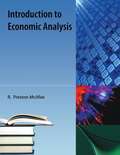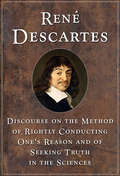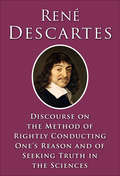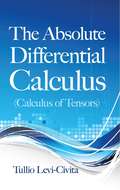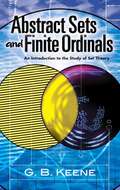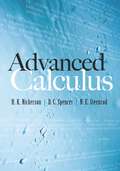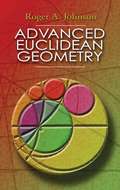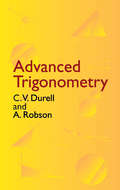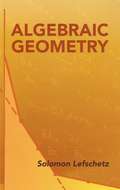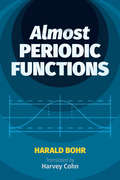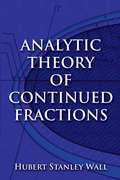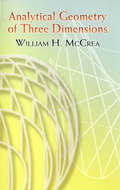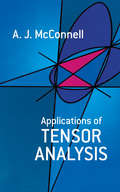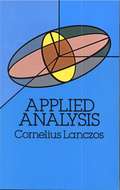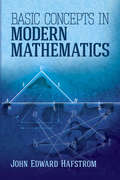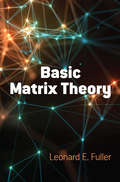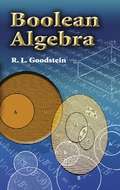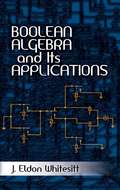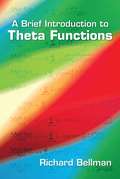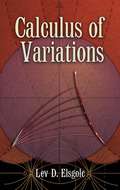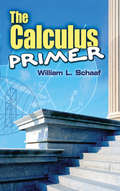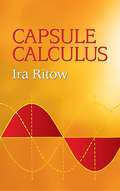- Table View
- List View
Elementary Algebra
by John ReddenIt is essential to lay a solid foundation in mathematics if a student is to be competitive in today's global market. The importance of algebra, in particular, cannot be overstated as it is the basis of all mathematical modeling used in applications found in all disciplines. Traditionally, the study of algebra is separated into a two parts, Elementary and Intermediate Algebra. This textbook by John Redden, Elementary Algebra, is the first part written in a clear and concise manner, making no assumption of prior algebra experience. It carefully guides students from the basics to the more advanced techniques required to be successful in the next course.
Intermediate Algebra
by John ReddenIt is essential to lay a solid foundation in mathematics if a student is to be competitive in today's global market. The importance of algebra, in particular, cannot be overstated, as it is the basis of all mathematical modeling used in applications found in all disciplines. Traditionally, the study of algebra is separated into a two parts, Elementary and Intermediate Algebra. This textbook by John Redden, Intermediate Algebra, is the second part. Written in a clear and concise manner, it carefully builds on the basics learned in Elementary Algebra and introduces the more advanced topics required for further study in applications found in most disciplines. Used as a standalone textbook, Intermediate Algebra offers plenty of review as well as something new to engage the student in each chapter. Written as a blend of the traditional and graphical approaches to the subject, this textbook introduces functions early and stresses the geometry behind the algebra. While CAS independent, a standard scientific calculator will be required and further research using technology is encouraged.
Introduction to Economic Analysis
by R. Preston Mcafee Tracy R. LewisThis book presents standard intermediate microeconomics material and some material that, in the authors' view, ought to be standard but is not. Introductory economics material is integrated. Standard mathematical tools, including calculus, are used throughout. The book easily serves as an intermediate microeconomics text, and can be used for a relatively sophisticated undergraduate who has not taken a basic university course in economics. The focus of this book is on the conceptual tools and not on fluff. As such, it reflects the approach actually adopted by the majority of economists for understanding economic activity. There are lots of models and equations, and no pictures of economists ;-) Economic analysis is used in many situations. When British Petroleum sets the price for Alaskan crude oil, it uses an estimated demand model, both for gasoline consumers and also for the refineries to which BP sells. Economic analysis was used by experts in the antitrust suit brought by the U.S. Department of Justice both to understand Microsoft s incentive to foreclose (eliminate from the market) rival Netscape and consumer behavior in the face of alleged foreclosure. Stock market analysts use economic models to forecast the profits of companies to predict the price of their stocks. When the government forecasts the budget deficit or considers a change in environmental regulations, it uses economic models. This book presents the building blocks of the models in common use by an army of economists thousands of times per day. This book, plus econometrics, provides most of the economic analysis tools to take upper division economics courses of any type.
Introduction to Economic Analysis
by R. Preston Mcafee Tracy R. LewisThis book presents standard intermediate microeconomics material and some material that, in the authors' view, ought to be standard but is not. Introductory economics material is integrated. Standard mathematical tools, including calculus, are used throughout. The book easily serves as an intermediate microeconomics text, and can be used for a relatively sophisticated undergraduate who has not taken a basic university course in economics. The focus of this book is on the conceptual tools and not on fluff. As such, it reflects the approach actually adopted by the majority of economists for understanding economic activity. There are lots of models and equations, and no pictures of economists ;-) Economic analysis is used in many situations. When British Petroleum sets the price for Alaskan crude oil, it uses an estimated demand model, both for gasoline consumers and also for the refineries to which BP sells. Economic analysis was used by experts in the antitrust suit brought by the U.S. Department of Justice both to understand Microsoft s incentive to foreclose (eliminate from the market) rival Netscape and consumer behavior in the face of alleged foreclosure. Stock market analysts use economic models to forecast the profits of companies to predict the price of their stocks. When the government forecasts the budget deficit or considers a change in environmental regulations, it uses economic models. This book presents the building blocks of the models in common use by an army of economists thousands of times per day. This book, plus econometrics, provides most of the economic analysis tools to take upper division economics courses of any type.
Discourse on the Method of Rightly Conducting One's Reason and of Seeking Truth in the Sciences
by René DescartesIn this work, René Descartes (1596-1650) outlines his "Method," which attempts to apply mathematical reasoning to all fields of inquiry. Starting with universal doubt, Descartes passes via his celebrated "I think, therefore I am," to the certainty of the existence of God.
Discourse on the Method of Rightly Conducting One's Reason and of Seeking Truth in the Sciences
by René DescartesIn this work,René Descartes (1596-1650) outlines his "Method," which attempts to apply mathematical reasoning to all fields of inquiry. Starting with universal doubt, Descartes passes via his celebrated "I think, therefore I am," to the certainty of the existence of God.
The Absolute Differential Calculus: Calculus Of Tensors (Dover Books on Mathematics)
by Tullio Levi-CivitaWritten by a towering figure of twentieth-century mathematics, this classic examines the mathematical background necessary for a grasp of relativity theory. Tullio Levi-Civita provides a thorough treatment of the introductory theories that form the basis for discussions of fundamental quadratic forms and absolute differential calculus, and he further explores physical applications.Part one opens with considerations of functional determinants and matrices, advancing to systems of total differential equations, linear partial differential equations, algebraic foundations, and a geometrical introduction to theory. The second part addresses covariant differentiation, curvature-related Riemann's symbols and properties, differential quadratic forms of classes zero and one, and intrinsic geometry. The final section focuses on physical applications, covering gravitational equations and general relativity.
Abstract Sets and Finite Ordinals: An Introduction to the Study of Set Theory
by G. B. KeeneThis text unites the logical and philosophical aspects of set theory in a manner intelligible both to mathematicians without training in formal logic and to logicians without a mathematical background. It combines an elementary level of treatment with the highest possible degree of logical rigor and precision.Starting with an explanation of all the basic logical terms and related operations, the text progresses through a stage-by-stage elaboration that proves the fundamental theorems of finite sets. It focuses on the Bernays theory of finite classes and finite sets, exploring the system's basis and development, including Stage I and Stage II theorems, the theory of finite ordinals, and the theory of finite classes and finite sets. This volume represents an excellent text for undergraduates studying intermediate or advanced logic as well as a fine reference for professional mathematicians.
Advanced Calculus
by D. C. Spencer H. K Nickerson N. E. SteenrodClassroom-tested in a Princeton University honors course, it offers students a unified introduction to advanced calculus. Starting with an abstract treatment of vector spaces and linear transforms, the authors introduce a single basic derivative in an invariant form. All other derivatives — gradient, divergent, curl, and exterior — are obtained from it by specialization. The corresponding theory of integration is likewise unified, and the various multiple integral theorems of advanced calculus appear as special cases of a general Stokes formula. The text concludes by applying these concepts to analytic functions of complex variables.
Advanced Euclidean Geometry
by Roger A. JohnsonFor many years, this elementary treatise on advanced Euclidean geometry has been the standard textbook in this area of classical mathematics; no other book has covered the subject quite as well. It explores the geometry of the triangle and the circle, concentrating on extensions of Euclidean theory, and examining in detail many relatively recent theorems. Several hundred theorems and corollaries are formulated and proved completely; numerous others remain unproved, to be used by students as exercises.The author makes liberal use of circular inversion, the theory of pole and polar, and many other modern and powerful geometrical tools throughout the book. In particular, the method of "directed angles" offers not only a powerful method of proof but also furnishes the shortest and most elegant form of statement for several common theorems. This accessible text requires no more extensive preparation than high school geometry and trigonometry.
Advanced Trigonometry
by A. Robson C. V. DurellThis volume will provide a welcome resource for teachers seeking an undergraduate text on advanced trigonometry, when few are readily available. Ideal for self-study, this text offers a clear, logical presentation of topics and an extensive selection of problems with answers. Contents include the properties of the triangle and the quadrilateral; equations, sub-multiple angles, and inverse functions; hyperbolic, logarithmic, and exponential functions; and expansions in power-series. Further topics encompass the special hyperbolic functions; projection and finite series; complex numbers; de Moivre's theorem and its applications; one- and many-valued functions of a complex variable; and roots of equations. 1930 edition. 79 figures.
Algebraic Geometry
by Solomon LefschetzThis text for advanced undergraduate students is both an introduction to algebraic geometry and a bridge between its two parts — the analytical-topological and the algebraic. Because of its extensive use of formal power series (power series without convergency), the treatment will appeal to readers conversant with analysis but less familiar with the formidable techniques of modern algebra. The book opens with an overview of the results required from algebra and proceeds to the fundamental concepts of the general theory of algebraic varieties: general point, dimension, function field, rational transformations, and correspondences. A concentrated chapter on formal power series with applications to algebraic varieties follows. An extensive survey of algebraic curves includes places, linear series, abelian differentials, and algebraic correspondences. The text concludes with an examination of systems of curves on a surface.
Almost Periodic Functions (Dover Books on Mathematics)
by Harvey Cohn Harald BohrMathematician Harald Bohr, motivated by questions about which functions could be represented by a Dirichlet series, devised the theory of almost periodic functions during the 1920s. His groundbreaking work influenced many later mathematicians, who extended the theory in new and diverse directions. In this volume, Bohr focuses on an essential aspect of the theory — the functions of a real variable — in full detail and with complete proofs.The treatment, which is based on Bohr's lectures, starts with an introduction that leads to discussions of purely periodic functions and their Fourier series. The heart of the book, his exploration of the theory of almost periodic functions, is supplemented by two appendixes that cover generalizations of almost periodic functions and almost periodic functions of a complete variable.
Analytic Theory of Continued Fractions (Dover Books on Mathematics)
by Hubert Stanley WallOne of the most authoritative and comprehensive books on the subject of continued fractions, this monograph has been widely used by generations of mathematicians and their students. Dr. Hubert Stanley Wall presents a unified theory correlating certain parts and applications of the subject within a larger analytic structure. Prerequisites include a first course in function theory and knowledge of the elementary properties of linear transformations in the complex plane. Some background in number theory, real analysis, and complex analysis may also prove helpful. The two-part treatment begins with an exploration of convergence theory, addressing continued fractions as products of linear fractional transformations, convergence theorems, and the theory of positive definite continued fractions, as well as other topics. The second part, focusing on function theory, covers the theory of equations, matrix theory of continued fractions, bounded analytic functions, and many additional subjects.
Analytical Geometry of Three Dimensions: Second Revised Version
by William H. McCreaBrief but rigorous, this text is geared toward advanced undergraduates and graduate students. It covers the coordinate system, planes and lines, spheres, homogeneous coordinates, general equations of the second degree, quadric in Cartesian coordinates, and intersection of quadrics.Mathematician, physicist, and astronomer, William H. McCrea conducted research in many areas and is best known for his work on relativity and cosmology. McCrea studied and taught at universities around the world, and this book is based on a series of his lectures.
Applications of Tensor Analysis (Dover Books on Mathematics)
by A. J. McConnellThis standard work applies tensorial methods to subjects within the realm of advanced college mathematics. In its four main divisions, it explains the fundamental ideas and the notation of tensor theory; covers the geometrical treatment of tensor algebra; introduces the theory of the differentiation of tensors; and applies mathematics to dynamics, electricity, elasticity, and hydrodynamics.Partial contents: algebraic preliminaries (notation, definitions, determinants, tensor analysis); algebraic geometry (rectilinear coordinates, the plane, the straight line, the quadric cone and the conic, systems of cones and conics, central quadrics, the general quadric, affine transformations); differential geometry (curvilinear coordinates, covariant differentiation, curves in a space, intrinsic geometry of a surface, fundamental formulae of a surface, curves on a surface); applied mathematics (dynamics of a particles, dynamics of rigid bodies, electricity and magnetism, mechanics of continuous media, special theory of relativity).
Applied Analysis: Prentice Hall Mathematics Series (Dover Books on Mathematics)
by Cornelius LanczosThis is a basic text for graduate and advanced undergraduate study in those areas of mathematical analysis that are of primary concern to the engineer and the physicist, most particularly analysis and design of finite processes that approximate the solution of an analytical problem. The work comprises seven chapters:Chapter I (Algebraic Equations) deals with the search for roots of algebraic equations encountered in vibration and flutter problems and in those of static and dynamic stability. Useful computing techniques are discussed, in particular the Bernoulli method and its ramifications.Chapter II (Matrices and Eigenvalue Problems) is devoted to a systematic development of the properties of matrices, especially in the context of industrial research.Chapter III (Large-Scale Linear Systems) discusses the "spectroscopic method" of finding the real eigenvalues of large matrices and the corresponding method of solving large-scale linear equations as well as an additional treatment of a perturbation problem and other topics.Chapter IV (Harmonic Analysis) deals primarily with the interpolation aspects of the Fourier series and its flexibility in representing empirically given equidistant data.Chapter V (Data Analysis) deals with the problem of reduction of data and of obtaining the first and even second derivatives of an empirically given function — constantly encountered in tracking problems in curve-fitting problems. Two methods of smoothing are discussed: smoothing in the small and smoothing in the large.Chapter VI (Quadrature Methods) surveys a variety of quadrature methods with particular emphasis on Gaussian quadrature and its use in solving boundary value problems and eignenvalue problems associated with ordinary differential equations.Chapter VII (Power Expansions) discusses the theory of orthogonal function systems, in particular the "Chebyshev polynomials."This unique work, perennially in demand, belongs in the library of every engineer, physicist, or scientist interested in the application of mathematical analysis to engineering, physical, and other practical problems.
Basic Concepts in Modern Mathematics (Dover Books on Mathematics)
by John Edward HafstromAn in-depth survey of some of the most readily applicable essentials of modern mathematics, this concise volume is geared toward undergraduates of all backgrounds as well as future math majors. By focusing on relatively few fundamental concepts, the text delves deeply enough into each subject to challenge students and to offer practical applications.The opening chapter introduces the program of study and discusses how numbers developed. Subsequent chapters explore the natural numbers; sets, variables, and statement forms; mappings and operations; groups; relations and partitions; integers; and rational and real numbers. Prerequisites include high school courses in elementary algebra and plane geometry.
Basic Matrix Theory
by Leonard E. FullerWritten as a guide to using matrices as a mathematical tool, this text is geared toward physical and social scientists, engineers, economists, and others who require a model for procedure rather than an exposition of theory. Knowledge of elementary algebra is the only mathematical prerequisite. Detailed numerical examples illustrate the treatment's focus on computational methods. The first four chapters outline the basic concepts of matrix theory. Topics include the development of the concept of elementary operations and a systematic procedure for simplifying matrices as well as a method for evaluating the determinant of a given square matrix. Subsequent chapters explore important numerical procedures, including the process for approximating characteristic roots and vectors plus direct and iterative methods for inverting matrices and solving systems of equations. Solutions to the problems are included.
Boolean Algebra
by R. L. GoodsteinFamous for the number-theoretic first-order statement known as Goodstein's theorem, author R. L. Goodstein was also well known as a distinguished educator. With this text, he offers an elementary treatment that employs Boolean algebra as a simple medium for introducing important concepts of modern algebra.The text begins with an informal introduction to the algebra of classes, exploring union, intersection, and complementation; the commutative, associative, and distributive laws; difference and symmetric difference; and Venn diagrams. Professor Goodstein proceeds to a detailed examination of three different axiomatizations, and an outline of a fourth system of axioms appears in the examples. The final chapter, on lattices, examines Boolean algebra in the setting of the theory of partial order. Numerous examples appear at the end of each chapter, with full solutions at the end.
Boolean Algebra and Its Applications (Dover Books on Computer Science)
by J. Eldon WhitesittThis introduction to Boolean algebra explores the subject on a level accessible even to those with a modest background in mathematics. The first chapter presents the algebra of sets from an intuitive point of view, followed by a formal presentation in chapter two of Boolean algebra as an abstract algebraic system, with no reference to applications. Succeeding chapters offer concise accounts of applications to symbolic logic, focusing on topics of logic common to elementary mathematics and discussing concepts of valid argument and indirect proofs. Additional topics include the algebra of circuits — switching, relay, and computer — as well as the application of the algebra of sets to probability theory. Problems appear throughout the text, with answers to selected problems at the end of the book. Geared toward students of mathematics, computer science, and electrical engineering, this text can be appreciated by anyone who understands college-level mathematics. It will prove particularly valuable to philosophy students and others wishing to study symbolic logic and its applications to computer science.
A Brief Introduction to Theta Functions (Dover Books on Mathematics)
by Richard BellmanBrief but intriguing, this monograph on the theory of elliptic functions was written by one of America's most prominent and widely read mathematicians. Richard Bellman encompasses a wealth of material in a succession of short chapters, spotlighting high points of the fundamental regions of elliptic functions and illustrating powerful and versatile analytic methods. Suitable for advanced undergraduates and graduate students in mathematics, this introductory treatment is largely self-contained. Topics include Fourier series, sufficient conditions, the Laplace transform, results of Doetsch and Kober-Erdelyi, Gaussian sums, and Euler's formulas and functional equations. Additional subjects include partial fractions, mock theta functions, Hermite's method, convergence proof, elementary functional relations, multidimensional Poisson summation formula, the modular transformation, and many other areas.
Calculus of Variations
by Lev D. ElsgolcThis concise text offers both professionals and students an introduction to the fundamentals and standard methods of the calculus of variations. In addition to surveys of problems with fixed and movable boundaries, it explores highly practical direct methods for the solution of variational problems.Topics include the method of variation in problems with fixed boundaries; variational problems with movable boundaries and other problems; sufficiency conditions for an extremum; variational problems of constrained extrema; and direct methods of solving variational problems. Each chapter features numerous illustrative problems, and solutions appear at the end.
The Calculus Primer
by William L. SchaafComprehensive but concise, this introduction to differential and integral calculus covers all the topics usually included in a first course. The straightforward development places less emphasis on mathematical rigor, and the informal manner of presentation sets students at ease. Many carefully worked-out examples illuminate the text, in addition to numerous diagrams, problems, and answers.Bearing the needs of beginners constantly in mind, the treatment covers all the basic concepts of calculus: functions, derivatives, differentiation of algebraic and transcendental functions, partial differentiation, indeterminate forms, general and special methods of integration, the definite integral, partial integration, and other fundamentals. Ample exercises permit students to test their grasp of subjects before moving forward, making this volume appropriate not only for classroom use but also for review and home study.
Capsule Calculus
by Ira RitowThis brief introductory text presents the basic principles of calculus from the engineering viewpoint. Excellent either as a refresher or as an introductory course, it focuses on developing familiarity with the basic principles rather than presenting detailed proofs.Topics include differential calculus, in terms of differentiation and elementary differential equations; integral calculus, in simple and multiple integration forms; time calculus; equations of motion and their solution; complex variables; complex algebra; complex functions; complex and operational calculus; and simple and inverse transformations. Advanced subjects comprise integrations and differentiation techniques, in addition to a more sophisticated variety of differential equations than those previously discussed.It is assumed that the reader possesses an acquaintance with algebra and trigonometry as well as some familiarity with graphs. Additional background material is presented as needed.

